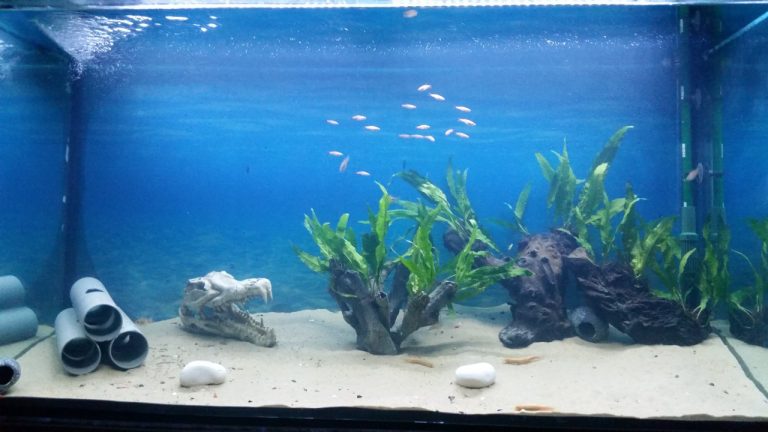Stop Snails: Keep Them in Your Aquarium with These Tips
To keep snails from crawling out of an aquarium, place mesh or a lid on top of the tank. Snails can be wonderful additions to an aquarium, but sometimes they can escape and wreak havoc in the surrounding environment.
Not only can snails damage plants and aquarium decorations, but they can also create a mess by crawling around on floors and surfaces. Fortunately, there are a few simple strategies to prevent snails from escaping their aquatic home. One of the easiest ways to keep snails contained is to place a secure lid or mesh over the top of the aquarium.
This will prevent snails from crawling out while still allowing air to circulate and maintain a healthy environment for aquatic plants and fish. Additionally, it is helpful to avoid overfeeding your snails and to maintain a clean aquarium to discourage them from seeking food or a place to hide outside of their tank.

Credit: www.ratemyfishtank.com
Understanding Snails In Aquariums
Snails are among the most fascinating inhabitants of aquariums, but keeping them in the aquarium is not always easy. One of the most common problems that aquarium owners encounter is snails crawling out of their tanks. In this blog post, we will discuss how to keep snails from crawling out of aquariums.
Let’s start by understanding snails in aquariums.
Explanation Of Snails As Aquarium Inhabitants
Snails are a common addition to aquariums because they help to keep the tank clean by consuming algae, fish waste, and other debris. They come in a variety of shapes, sizes, and colors, making them a beautiful and unique addition to any tank.
Pros And Cons Of Having Snails In Aquariums
While having snails in your aquarium can provide many benefits, there are also some downsides. Here are some pros and cons of having snails in aquariums:
Pros:
- Snails reduce the amount of algae and debris in the tank
- They are fascinating creatures to watch
- Snails can reproduce quickly, creating a sustainable food source for other tank inhabitants
Cons:
- Snails can overpopulate, causing an imbalance in the tank ecosystem
- Some snail species can damage live aquarium plants
- Snails can carry diseases that can potentially harm other tank inhabitants
Types Of Snails Found In Aquariums
There are many different species of snails found in aquariums, each with their own unique characteristics. Here are some common types of snails found in aquariums:
- Mystery snails
- Nerite snails
- Ramshorn snails
- Trumpet snails
- Assassin snails
Proper Snail Identification
To properly care for your aquarium, it’s important to be able to identify the types of snails in your tank. Here are some tips to help you identify snails in your aquarium:
- Look at the shell shape, color, and size
- Observe their behavior, feeding habits, and activity level
- Research the species characteristics online or in aquarium books.
Understanding snails in aquariums is an important step in keeping them healthy and ensuring that they don’t crawl out of the tank. Consider the pros and cons of having snails in your aquarium, and identify the types of snails in your tank by carefully observing their characteristics.
Following these tips will help you maintain a healthy and thriving aquarium environment.
Factors Contributing To Snail Infestation
Aquariums housing snails can be an excellent addition to a home or office setting. However, when aquarium owners notice their snails crawling out of the tank, it presents a problem. Snails can be harmful to aquatic life and cause unwanted algae growth if not managed correctly.
We’ll examine the factors contributing to snail infestation, and how to prevent it from happening.
Causes Of Snail Infestation In Aquariums
Various factors can cause snail infestations in aquariums, including:
- Adding live plants to the aquarium without inspection
- Overfeeding fish in the tank
- Using snail-infested substrate or decorations in the tank
- Introducing snails accidentally while adding new fish
How To Identify A Potential Snail Infestation
Identifying a potential snail infestation in the aquarium is relatively simple. Here’s what to look for:
- Small snails crawling along the glass or substrate surface
- Snail eggs on the glass or decoration surfaces
The presence of these snails and eggs inside the aquarium suggests that a snail infestation is underway.
Prevention Measures For Snail Infestations
The best way to avoid a snail infestation in your aquarium is to prevent it before it happens. Here are some measures to put in place:
- Inspect all live plants for snails or eggs before planting them in the aquarium.
- Avoid overfeeding fish to reduce excess food particles in the tank, which snails feed on.
- Clean the substrate and decor using a bleach solution before introducing them into the tank.
- Quarantine new fish in a separate tank before introducing them into the main tank.
- Use snail-catching fish, such as loaches, to control snail populations.
Keeping snails from crawling out of an aquarium can be challenging, but not impossible. By following the measures mentioned above, you can prevent snail infestations from occurring in your aquarium. Ultimately, maintaining a clean and healthy aquatic environment is essential for the well-being of your underwater ecosystem.
Natural Methods For Controlling Snail Infestation
Snails can be beneficial to an aquarium as they help in cleaning by consuming algae and debris. However, an overabundance of snails can cause harm to aquatic life by consuming plants and other essential elements in the aquarium. Fortunately, there are natural methods to control the population of snails in an aquarium.
Using Snail-Eating Fish As A Solution
Some fish species are natural predators of snails. Adding snail-eating fish into the aquarium can naturally control and minimize the snail population. Loaches, clownfish, and botia strains are popular fish breeds that enjoy snails as a food source. It is essential to research before adding any fish to ensure they are compatible with the aquarium’s current inhabitants and environment.
Cleaning The Aquarium Regularly
An unclean aquarium can be a breeding ground for snails. Regular cleaning of the aquarium is necessary to limit the growth of snails. It is crucial to vacuum the gravel, remove any decaying plant material and uneaten food timely to reduce the number of snails.
Keeping the tank clean and well-maintained limits the quantity of food and habitat, thus reducing snail growth chances.
Using Plants To Control Snail Population
Adding different types of aquatic plants to the aquarium is another natural way of controlling snail populations. Decaying and decomposing plant material is a potential food source for snails. Live plants will consume the food source of the snails, depriving them of food, and control the population.
You can include java fern and amazon sword to help limit the snail growth rate.
Adjusting Feeding Habits To Prevent Excess Food Accumulation
Feeding habits can encourage snail growth in the aquarium. Overfeeding the fish can create excess food that results in a surplus of snails. Careful feeding and adjusting feeding times can help in reducing the snail population. It is better to feed the fish lightly and watch them consume the food in a matter of seconds before adding more.
Also, minimize the amount of time that uneaten food stays in the aquarium.
While snails can contribute to the aquarium’s ecological system, their overpopulation can cause more harm than good. Using natural methods such as introducing snail-eating fish, cleaning regularly, using plants, and adjusting feeding habits can help balance the snail population. These methods not only reduce snail growth but also help improve the overall aquarium’s quality of life.
Chemical Methods For Controlling Snail Infestation
Snails are fascinating aquatic creatures that many people keep as pets. While they can be fun to watch, they can also be a headache for aquarium owners. The problem with snails is that they breed quickly, and their offspring can quickly overtake the aquarium.
If you’re struggling with snail infestation in your aquarium, you may want to consider using chemical methods to control the problem. Here’s what you need to know about using chemical methods for controlling snail infestation.
Overview Of Chemical Methods For Controlling Snails
Using chemicals to control snail infestation can be an effective way to deal with the problem. However, it’s important to understand the different chemicals available and how to use them safely. Most chemicals work by eliminating the snails or their eggs, so it’s important to use them correctly to avoid harming other aquatic life in the aquarium.
Detailed Description Of Chemical Options Available
There are several chemical options available for controlling snail infestations in aquariums. Some of the most common options include:
- Copper sulfate
- Potassium permanganate
- Formalin
- Hydrogen peroxide
Each of these chemicals has its own benefits and drawbacks, so it’s important to research them thoroughly to determine which one is right for your needs.
Instructions On How To Apply Chemical Methods
When applying chemical methods to control snail infestations, it’s important to follow the manufacturer’s instructions carefully. In general, you’ll need to determine the appropriate dosage for your tank size and add the chemical to the water slowly over a period of several hours.
You’ll also need to remove any snails or eggs from the tank before adding the chemical, as some chemicals can be harmful to other aquatic life.
Precautionary Measures When Using Chemicals
Using chemicals to control snail infestations can be dangerous if not done properly. Here are some precautionary measures that you should take:
- Wear protective gloves and eyewear
- Keep the chemicals away from children and pets
- Use the chemicals in a well-ventilated area
- Follow the manufacturer’s instructions carefully
- Monitor the water quality closely after using chemicals
By following these precautions, you can minimize the risks associated with using chemicals in your aquarium.
Risks And Pitfalls Of Using Chemical Methods For Snail Control
While chemical methods can be effective for controlling snail infestations, they also come with some risks and pitfalls. Overdosing the tank with chemicals can harm other aquatic life, including fish, shrimp, and plants. Additionally, some chemicals can be harmful to humans if inhaled or ingested.
It’s important to use these methods with caution and to carefully monitor the water quality after using them.
Using chemical methods to control snail infestations in aquariums can be an effective way to deal with the problem. However, it’s important to use them properly to avoid harming other aquatic life or yourself. Be sure to research the different options available and follow the manufacturer’s instructions carefully.
With diligence and care, you can keep your aquarium healthy and snail-free.
Frequently Asked Questions On How To Keep Snails From Crawling Out Of Aquarium
How Do Snails Escape From The Aquarium?
Snails can escape through any openings on the lid or filter system.
Do Snails Pose Any Harm To The Aquarium?
Snails can multiply quickly and cause harm to plants and other species in the aquarium.
What Are Some Common Methods To Prevent Snail Escape?
Covering the aquarium with a mesh lid or sealing gaps and holes can prevent snail escape.
How Can I Get Rid Of Snails In My Aquarium?
Reducing feeding, manually removing snails, and using snail traps or treatments can eliminate snails from the aquarium.
Conclusion
Overall, keeping snails from crawling out of an aquarium requires attention to detail and a willingness to experiment with different strategies. From sealing any possible escape routes to adding natural predators and controlling water quality, there are several effective ways to keep snails in their place.
It’s essential to be patient, persistent and proactive in your approach since these slimy creatures can quickly take over your aquarium if left unchecked. Remember that prevention is always easier than cure, so start by minimizing the presence of snails in your tank.
With trial and error, you’ll discover what works best for your specific situation and successfully keep your aquarium snail-free for years to come. Just remember that with the right techniques, it’s possible to enjoy a thriving aquarium that’s both beautiful and bug-free.






